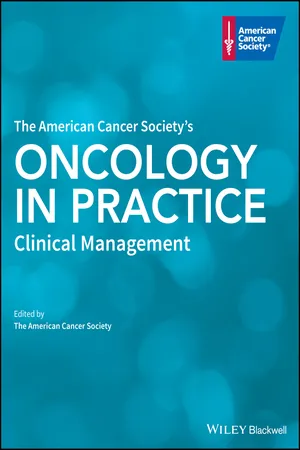1
Lung Cancer
Suresh S. Ramalingam and Fadlo R. Khuri
Emory University School of Medicine, Atlanta, Georgia, USA
Incidence and Mortality
Lung cancer is the most commonly diagnosed cancer worldwide with an estimated 1.8 million new cases each year. This accounts for approximately 13% of all cancers in the world. With an estimated 1.6 million deaths each year, lung cancer is also the leading cause of cancer‐related mortality globally [1, 2]. Among men, lung cancer is the most common malignancy, whereas in women, lung cancer incidence is exceeded only by breast and colorectal cancers. The estimated incidence rates of lung cancer in more developed countries are 18.6 per 100,000 women per year and 47.4 per 100,000 in men per year. The corresponding rates for less developed countries are 11.1 and 27.8 for women and men, respectively. The mortality related to lung cancer in men has declined in the past two decades in the Western countries, but is increasing rapidly in the developing world. However, in women the incidence and mortality related to lung cancer continues on an upward trend in most regions of the world. In the United States (US), an estimated 222,500 cases of lung cancer will be diagnosed in the year 2017 and approximately 155,870 deaths will result from lung cancer [3]. In Europe, an estimated 417,000 cases of lung cancer are diagnosed annually with approximately 367,000 deaths each year [4]. China has experienced a 465% increase in the deaths related to lung cancer over the past 30 years [5]. With approximately 500,000 new cases annually, lung cancer is the most common cancer in China in both men and women. Based on the increasing incidence of cigarette smoking in the developing world, it is estimated that most lung cancers cases will occur outside the US and Europe by the year 2030.
Risk Factors
Cigarette smoking is the most common risk factor for lung cancer. Nearly 85% of patients with lung cancer have a history of smoking tobacco products. Among them, approximately 50% are former smokers, defined as being free from smoking for at least 12 months before the diagnosis of lung cancer. The risk of developing lung cancer is proportional to the number of cigarettes smoked per day and the cumulative duration of smoking time. Patients with a smoking history of more than 20–30 pack years are considered to be at high risk for developing lung cancer. Though the prevalence of cigarette smoking is declining in the US, it is increasing at an alarming rate in developing and third world countries. Consequently, the number of cases of lung cancer diagnosed annually is likely to rise over the next few decades. Smoking cessation is associated with a gradual reduction in risk of lung cancer, though it does not reach that of a never‐smoker. Since fewer than 20% of heavy smokers develop lung cancer, genetic susceptibility to lung cancer also appears to play a risk. Women appear to be at a higher risk of developing lung cancer compared to men. In recent years, there are an increasing number of never‐smokers diagnosed with lung cancer. The tumors in these individuals are more likely to harbor certain genetic alterations such as mutations in the epidermal growth factor receptor (EGFR) gene, and rearrangement in the anaplastic lymphoma kinase (ALK) gene [6]. Second‐hand exposure to smoke is another risk factor that contributes to nearly 1% of all cases of lung cancer.
Occupational exposure to asbestos is a known risk factor for lung cancer [7, 8]. It is estimated that in patients without a smoking history, there is a fourfold higher risk of lung cancer with asbestos exposure. Cigarette smoking has an additive effect on increasing the risk of lung cancer associated with asbestos exposure [9]. Although the use of asbestos is banned in nearly 50 countries in the world, it is on the rise in China, India, Russia, and many other countries. The Environmental Protection Agency (EPA) and the World Health Organization consider all forms of asbestos as carcinogenic. There is a latency of a few decades between asbestos exposure and the development of lung cancer. The risk of developing lung cancer from asbestos is related to the duration of exposure, quantity, and the type of asbestos fiber.
Radon exposure has also been implicated in the development of lung cancer [10]. Radon results from the radioactive decay of uranium. Household exposure to radon in certain geographical regions is high and contributes to nearly 20,000 new cases of lung cancer each year, according to an EPA estimate [11]. The EPA recommends that household radon levels should be <4 picocuries/L of air to minimize the risk of developing lung cancer. Simple remedial methods are available to reduce radon exposures above this threshold. Exposure to ionizing radiation in the form of therapeutic radiation, or frequent diagnostic radiographic tests is also associated with a higher risk of developing lung cancer. Industrial exposure to metals such as arsenic, nickel, chromium, and general air pollution have all been linked to a higher risk of lung cancer. There are no known familial genetic syndromes associated with lung cancer.
Pathology
Historically, lung cancer was broadly subdivided into nonsmall cell lung cancer (NSCLC) and small cell lung cancer (SCLC), based on the distinct behavior and response to chemotherapy between these two subsets of patients. NSCLC constitutes adenocarcinoma, squamous cell carcinoma and large cell carcinoma subtypes. In the past few years, distinct differences between the various subhistologies of NSCLC have been recognized and an increasing emphasis is placed on the identification of subtypes from diagnostic specimens.
Adenocarcinoma is the most common histologica...
